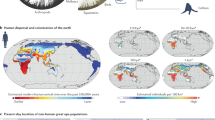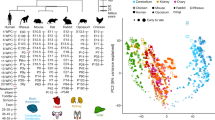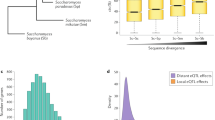Key Points
-
Specification of the animal body plan and coordination of its development are accomplished through the regulation of complex networks of genes.
-
Molecular variation in gene sequences results in phenotypic variation in populations, which is the raw material on which evolutionary forces act.
-
Functional genomics technologies promise to accelerate the study of development and of evolution.
-
A synthetic approach, using the tools of molecular genetics and genomics, quantitative and population genetics, experimental evolution and comparative biology, is required to study the complex molecular basis of evolutionary change.
Abstract
It has rarely been possible to connect the developmental and evolutionary branches of genetics, particularly with regard to the precise changes in the molecular control of development that are responsible for phenotypic variation and evolution. Making such connections will require a high-resolution molecular description of the genetic networks that underlie development and an understanding of their responses to genetic and environmental variation. Functional genomics approaches to development and evolution promise to accelerate the research necessary to accomplish these goals.
This is a preview of subscription content, access via your institution
Access options
Subscribe to this journal
Receive 12 print issues and online access
$189.00 per year
only $15.75 per issue
Buy this article
- Purchase on Springer Link
- Instant access to full article PDF
Prices may be subject to local taxes which are calculated during checkout

Similar content being viewed by others
References
Lewontin, R. C. The Genetic Basis of Evolutionary Change (Columbia Univ. Press, New York, 1974). Lewontin's treatment of the fundamental outstanding issues in evolutionary genetics is often more relevant today than it was 25 years ago. Particularly in his lament about the lack of a genotype-to-phenotype map, only now can we envisage providing the experimental data that will fill the gap raised in this classic book.
Waddington, C. H. The Strategy of the Genes: a Discussion of Some Aspects of Theoretical Biology (George Allen and Unwin Ltd, 1957).
Huxley, J. Evolution: The Modern Synthesis (Harper & Brothers, London, 1942).
Dobzhansky, Th. G. Genetics and the Origin of Species (Columbia Univ. Press, New York, 1937). This text, along with aspects of Fisher's The Genetical Theory of Natural Selection seven years earlier, provided the basis for the neoDarwinian synthesis.
Wright, S. Evolution and the Genetics of Populations (Chicago Univ. Press, Chicago, Illinois, 1968–1978).
Hartl, D. L. & Clark, A. G. Principles of Population Genetics (Sinauer Associates, Sunderland, Massachusetts, 1997).
Kreitman, M. & Comeron, J. M. Coding sequence evolution. Curr. Opin. Genet. Dev. 9, 637–641 (1999).
Kondrashov, A. S. Comparative genomics and evolutionary biology. Curr. Opin. Genet. Dev. 9, 624–629 (1999).
Fisher, R. A. The Genetical Theory of Natural Selection 2nd edn (Dover, New York, 1958).
Eshel, I. & Feldman, M. W. On evolutionary genetic stability of the sex ratio. Theor. Popul. Biol. 21, 430–439 (1982).
Wagner, G. P. What is the promise of developmental evolution? I. Why is developmental biology necessary to explain evolutionary innovations? J. Exp. Zool. 288, 95–98 (2000).
Mezey, J. G., Cheverud, J. M. & Wagner, G. P. Is the genotype–phenotype map modular? A statistical approach using mouse quantitative trait loci data. Genetics 156, 305–311(2000).
Sucena, E. & Stern, D. L. Divergence of larval morphology between Drosophila sechellia and its sibling species caused by cis-regulatory evolution of ovo/shaven-baby. Proc. Natl Acad. Sci. USA 97, 4530–4534 (2000).
Kopp, A., Duncan, I. & Carroll, S. B. Genetic control and evolution of sexually dimorphic characters in Drosophila. Nature 408, 553–559 (2000).
Kearsey, M. J. & Pooni, H. S. The Genetical Analysis of Quantitative Traits (Chapman & Hall, London, 1996).
Falconer, D. S. & MacKay, T. F. C. Introduction to Quantitative Genetics (Wiley, New York, 1996).
Risch, N. J. Searching for genetic determinants in the new millennium. Nature 405, 847–856 (2000).
Mackay, T. F. C. Quantitative trait loci in Drosophila. Nature Rev. Genet. 2, 11–20 (2001).
Mackay, T. F. C. & Langley, C. H. Molecular and phenotypic variation in the Achaete-scute region of Drosophila melanogaster. Nature 348, 64–66 (1990). Shows an important experimental model for correlating naturally occurring molecular genetic polymorphisms with phenotypic polymorphisms using candidate loci known to be involved in the development of the structures (bristles) being scored.
Lai, C., Lyman, R. F., Long, A. D., Langley, C. H. & Mackay, T. F. C. Naturally occurring variation in bristle number and DNA polymorphisms at the scabrous locus of Drosophila melanogaster. Science 266, 1697–1702 (1994).
Doebley, J., Stec, A. & Gustus, C. teosinte branched 1 and the origin of maize: evidence for epistasis and the evolution of dominance. Genetics 141, 333–346 (1995).
Doebley, J., Stec, A. & Hubbard, L. The evolution of apical dominance in maize. Nature 386, 485–488 (1997).
Schena, M., Shalon, D., Davis, R. W. & Brown, P. O. Quantitative monitoring of gene expression patterns with a complementary DNA microarray. Science 270, 467–470 (1995).
Shalon, D., Smith, S. J. & Brown, P. O. A DNA microarray system for analyzing complex DNA samples using two-color fluorescent probe hybridization. Genome Res. 6, 639–645 (1996).
Lockhart, D. J. et al. Expression monitoring by hybridization to high-density oligonucleotide arrays. Nature Biotechnol. 14, 1675–1680 (1996).
DeRisi, J. L., Iyer, V. R. & Brown, P. O. Exploring the metabolic and genetic control of gene expression on a genomic scale. Science 278, 680–686 (1997). This application of microarray-based transcriptional profiling to the study of metabolic flux stimulated many other researchers to consider using functional genomics approaches to assist their own biological problems.
Chu, S. et al. The transcriptional program of sporulation in budding yeast. Science 282, 699–705 (1998).
White, K. P., Rifkin, S. A., Hurban, P. & Hogness, D. S. Microarray analysis of Drosophila development during metamorphosis. Science 286, 2179–2184 (1999).
Reinke, V. et al. A global profile of germline gene expression in C. elegans. Mol. Cell 6, 605–616 (2000).
Eisen, M. B., Spellman, P. T., Brown, P. O. & Botstein, D. Cluster analysis and display of genome-wide expression patterns. Proc. Natl Acad. Sci. USA 95, 14863–14868 (1998).
Tamayo, P. et al. Interpreting patterns of gene expression with self-organizing maps: methods and application to hematopoietic differentiation. Proc. Natl Acad. Sci. USA 96, 2907–2912 (1999).
Ren, B. et al. Genome-wide location and function of DNA binding proteins. Science 290, 2306–2309 (2000). This paper, along with a similar one by Iyer et al . published a month later in Nature , showed the feasibility of mapping DNA–protein interactions genome-wide and combining such information with transcriptional profiling. Integration of several types of functional genomic data promises to help resolve complex genetic networks.
Iyer, V. R. et al. Genomic binding sites of the yeast cell-cycle transcription factors SBF and MBF. Nature 409, 533–538 (2001).
Van Steensel, B., Delrow, J. & Henikoff, S. Chromatin profiling using targeted DNA adenine methyltransferase. Nature Genet. 27, 304–308 (2001).
Ideker, O. Integrating genomic and proteomic analyses of a systematically perturbed metabolic network. Science 292, 929–934 (2001).
Hartemink, A. J., Gifford, D. K., Jaakkola, T. S. & Young, R. A. Using graphical models and genomic expression data to statistically validate models of genetic regulatory networks. Pac. Symp. Biocomput. 422–433 (2001).
Orr, H. A. & Presgraves, D. C. Speciation by postzygotic isolation: forces, genes and molecules. Bioessays 22, 1085–1094 (2000). A recent and thorough review of the genetics of postzygotic isolation.
Hollocher, H. & Wu, C. I. The genetics of reproductive isolation in the Drosophila simulans clade: X vs. autosomal effects and male vs. female effects. Genetics 143, 1243–1255 (1996).
Ting, C. T., Tsaur, S. C., Wu, M. L. & Wu, C. I. A rapidly evolving homeobox at the site of a hybrid sterility gene. Science 282, 1501–1504 (1998).
Meyer, A., Kocher, T. D., Basasibwaki, P. & Wilson, A. C. Monophyletic origin of Lake Victoria cichlid fishes suggested by mitochondrial DNA sequences. Nature 347, 550–553 (1990).
Sturmbauer, C. & Meyer, A. Genetic divergence, speciation and morphological stasis in a lineage of African cichlid fishes. Nature 358, 578–581 (1992).
Grant, P. R. & Grant, B. R. Genetics and the origin of bird species. Proc. Natl Acad. Sci. USA 94, 7768–7775 (1997).
Myers, E. W. et al. A whole-genome assembly of Drosophila. Science 287, 2196–2204 (2000).
Powell, J. R., Caccone, A., Gleason, J. M. & Nigro, L. Rates of DNA evolution in Drosophila depend on function and developmental stage of expression. Genetics 133, 291–298 (1993).
Kliman, R. M. et al. The population genetics of the origin and divergence of the Drosophila simulans complex species. Genetics 156, 1913–1931 (2000).
Schmid, K. J. & Tautz, D. A screen for fast evolving genes from Drosophila. Proc. Natl Acad. Sci. USA 94, 9746–9750 (1997).
Horn, C. & Wimmer, E. A. A versatile vector set for animal transgenesis. Dev. Genes Evol. 210, 630–637 (2000).
MacDowell, E. C. Bristle inheritance in Drosophila. II. Selection. J. Exp. Zool. 30, 419–460 (1917).
Sturtevant, A. H. An Analysis of the Effects of Selection (Publication 264, Carnegie Institute of Washington, 1918).
Payne, F. The effect of artificial selection on bristle number in Drosophila ampelophila and its interpretation. Proc. Natl Acad. Sci. USA 4, 55–58 (1918).
Flexon, P. B. & Rodell, C. F. Genetic recombination and directional selection for DDT resistance in Drosophila melanogaster. Nature 298, 672–674 (1982).
Hirsch, J. & Erlenmyer-Kimling, L. Sign of taxis as a property of the genotype. Science 134, 835–836 (1961).
Dobzhansky, Th. & Spassky, B. Artificial and natural selection for two behavioral traits in Drosophila pseudoobscura. Proc. Natl Acad. Sci. USA 62, 75–80 (1969). An important demonstration of the malleability of complex, and in this case behavioural, traits under selection in Drosophila.
Joshi, A., Knight, C. D. & Mueller, L. D. Genetics of larval urea tolerance in Drosophila melanogaster. Heredity 77, 33–39 (1996).
Mueller, L. D. Evolution of competitive ability in Drosophila by density-dependent natural selection. Proc. Natl Acad. Sci. USA 85, 4383–4386 (1988).
Rose, M. R. Genetics of increased lifespan in Drosophila. Bioessays 11, 132–135 (1989).
Partridge, L., Prowse, N. & Pignatelli, P. Another set of responses and correlated responses to selection on age at reproduction in Drosophila melanogaster. Proc. R. Soc. Lond. B 266, 255–261 (1999).
Stearns, S. C. Life history evolution: successes, limitations, and prospects. Naturwissenschaften 87, 476–486 (2000).
Villares, R. & Cabrera, C. V. The Achaete-scute gene complex of D. melanogaster: conserved domains in a subset of genes required for neurogenesis and their homology to myc. Cell 50, 415–424 (1987).
Powell, P. A., Wesley, C., Spencer, S. & Cagan, R. L. Scabrous complexes with Notch to mediate boundary formation. Nature 409, 626–630 (2001).
Long, A. D. et al. High resolution mapping of genetic factors affecting abdominal bristle number in Drosophila melanogaster. Genetics 139, 1273–1291 (1995).
Amlou, M., Moreteau, B. & David, J. R. Larval tolerance in the Drosophila melanogaster species complex toward the two toxic acids of the D. sechellia host plant. Hereditas 129, 7–14 (1998).
Jones, C. D. The genetic basis of Drosophila sechellia's resistance to a host plant toxin. Genetics 149, 1899–1908 (1998).
Haff, L. A. & Smirnov, I. P. Single-nucleotide polymorphism identification assays using a thermostable DNA polymerase and delayed extraction MALDI-TOF mass spectrometry. Genome Res. 7, 378–388 (1997).
Cai, H. et al. Flow cytometry-based minisequencing: a new platform for high-throughput single-nucleotide polymorphism scoring. Genomics 66, 135–143 (2000).
Ronaghi, M., Uhlen, M. & Nyren, P. A sequencing method based on real-time pyrophosphate. Science 281, 363–365 (1998).
Chee, M. et al. Accessing genetic information with high-density DNA arrays. Science 274, 610–614 (1996).
Zhong, X. B., Lizardi, P. M., Huang, X. H., Bray-Ward, P. L. & Ward, D. C. Visualization of oligonucleotide probes and point mutations in interphase nuclei and DNA fibers using rolling circle DNA amplification. Proc. Natl Acad. Sci. USA 98, 3940–3945 (2001).
Lyamichev, V. et al. Polymorphism identification and quantitative detection of genomic DNA by invasive cleavage of oligonucleotide probes. Nature Biotechnol. 17, 292–296 (1999).
Lander, E. S. et al. Initial sequencing and analysis of the human genome. Nature 409, 860–921 (2001).
Dobzhansky, Th. Studies on hybrid sterility. II. Localization of sterility factors in Drosophila psuedoobscura hybrids. Genetics 21, 113–135 (1936).
Prakash, S. Origin of reproductive isolation in the absence of apparent genic differentiation in a geographic isolate of Drosophila pseudoobscura. Genetics 72, 143–155 (1972).
Noor, M. A. Speciation driven by natural selection in Drosophila. Nature 375, 674–675 (1995).
Travisano, M., Mongold, J. A., Bennett, A. F. & Lenski, R. E. Experimental tests of the roles of adaptation, chance, and history in evolution. Science 267, 87–90 (1995).
Elena, S. F., Cooper, V. S. & Lenski, R. E. Punctuated evolution caused by selection of rare beneficial mutations. Science 272, 1802–1804 (1996).
Arjan, J. A. et al. Diminishing returns from mutation supply rate in asexual populations. Science 283, 404–406 (1999).
Paquin, C. & Adams, J. Frequency of fixation of adaptive mutations is higher in evolving diploid than haploid yeast populations. Nature 302, 495–500 (1983).
Ferea, T. L., Botstein, D., Brown, P. O. & Rosenzweig, R. F. Systematic changes in gene expression patterns following adaptive evolution in yeast. Proc. Natl Acad. Sci. USA 96, 9721–9726 (1999).
Riehle, M. M., Bennett, A. F. & Long, A. D. Genetic architecture of thermal adaptation in Escherichia coli. Proc. Natl Acad. Sci. USA 98, 525–530 (2001).
Acknowledgements
I thank D. Houle and J. Kim who read versions of this manuscript and provided many useful discussions.
Author information
Authors and Affiliations
Related links
Related links
DATABASE LINKS
FURTHER INFORMATION
ENCYCLOPEDIA OF LIFE SCIENCES
Evolutionary developmental biology: developmental and genetic mechanisms of evolutionary change
Glossary
- DRIFT
-
Mutation, drift and selection are the three forces of evolution on which most population genetics theory is based. Drift refers to random fluctuations in allele and, less commonly, phenotype frequencies as genes are transmitted from one generation to the next.
- GENETIC NETWORK
-
A system of interactions among genes and their products. In creating a phenotype, genetic networks are influenced both by their constituents and the environment in which the organism develops.
- MICROEVOLUTIONARY
-
An evolutionary pattern observed over a short period of time (up to hundreds of generations for animals or plants, and up to tens of thousands of generations for microbes).
- QUANTITATIVE TRAIT
-
A measurable trait that depends on the cumulative action of many genes (or quantitative trait loci).
- DENTICLE BELTS
-
Segmentally repeated features of the cuticle that are made up of tiny, rigid hair-like structures.
- SEXUAL DIMORPHISM
-
Difference of physical form between the sexes.
- TEOSINTE
-
The wild progenitor of maize.
- FUNCTIONAL GENOMICS
-
The development and application of global (genome-wide or system-wide) experimental approaches to assess gene function by making use of information and reagents provided by physical mapping and sequencing of genomes.
- DNA MICROARRAYS
-
Devices used to interrogate complex nucleic acid samples by hybridization. They make it possible to quantitate the amount of different nucleic acid molecules that are present in a sample of interest.
- DIAUXIC SHIFT
-
The process of switching from anaerobic to aerobic respiration.
- MESODERM
-
In animals with three tissue layers, the mesoderm is the middle layer of tissue, between the ectoderm and the endoderm. In vertebrates, it forms the skeleton, muscles, heart, spleen and many other internal organs.
- BAYESIAN NETWORK
-
A graph with one-way edges that connect nodes. The nodes represent assertions about relationships between them. For example, node A is related to a node B by an edge that represents that A is a cause of B, with a certain probability. Networks with many interconnected nodes can be constructed.
- MASS SPECTROMETRY
-
A technique that provides accurate information about the molecular mass and structure of complex molecules. It can identify and quantify extremely small amounts of drugs or metabolites by their mass-fragment spectrum.
- FLOW CYTOMETRY
-
Analysis of biological material by detecting the light-absorbing or fluorescing properties of cells or subcellular fractions (that is, chromosomes) passing in a narrow stream through a laser beam.
- PREZYGOTIC/POSTZYGOTIC ISOLATION
-
In prezygotic isolation, reproductive barriers can take the form of behavioural differences such as at the level of mate selection. In postzygotic isolation, genetic independence of different populations is maintained because of hybrid sterility and/or inviability.
- ASSOCIATION STUDIES
-
A set of methods used to correlate polymorphisms in genotype to polymorphisms in phenotype in populations.
- CLADE
-
A taxon or other grouping of organisms consisting of a single species and its descendents. The Drosophila melanogaster group of species numbers about 150. Within this group there is a melanogaster subgroup of nine species: D. melanogaster, D. simulans, D. sechellia, D. mauritiana, D. teissieri, D. santomea, D. yakuba, D. erecta and D. orena.
- SYMPATRY
-
The condition in which the distributions of two species overlap and hybridization between taxa would be possible if they were not reproductively isolated by factors other than spatial separation.
- GEOTAXIS
-
Movement in response to gravity.
- LIFE HISTORY
-
The reproductive strategy of an organism.
- VARIANCE
-
A statistic describing the dispersion about the mean.
- STERNOPLEURAL BRISTLES
-
Bristles on the thorax situated between the first and second pair of legs of Drosophila.
- PUNCTUATED EQUILIBRIUM
-
A model of evolution in which change occurs in relatively rapid bursts, followed by a longer period of stasis. Also referred to as punctuated equilibrium.
- ANTAGONISTIC PLEIOTROPY
-
The concept that changes associated with the evolution of selected traits can cause correlated negative changes in fitness.
Rights and permissions
About this article
Cite this article
White, K. Functional genomics and the study of development, variation and evolution. Nat Rev Genet 2, 528–537 (2001). https://doi.org/10.1038/35080565
Issue Date:
DOI: https://doi.org/10.1038/35080565
This article is cited by
-
Comparison of microarray and RNA-Seq analysis of mRNA expression in dermal mesenchymal stem cells
Biotechnology Letters (2016)
-
Transcriptional pathways associated with the slow growth phenotype of transformed Anaplasma marginale
BMC Genomics (2013)
-
Translog, a web browser for studying the expression divergence of homologous genes
BMC Bioinformatics (2010)
-
Functional genomics of the pregnant uterus: from expectations to reality, a compilation of studies in the myometrium
BMC Pregnancy and Childbirth (2007)
-
Evolution of gene expression in the Drosophila melanogaster subgroup
Nature Genetics (2003)



